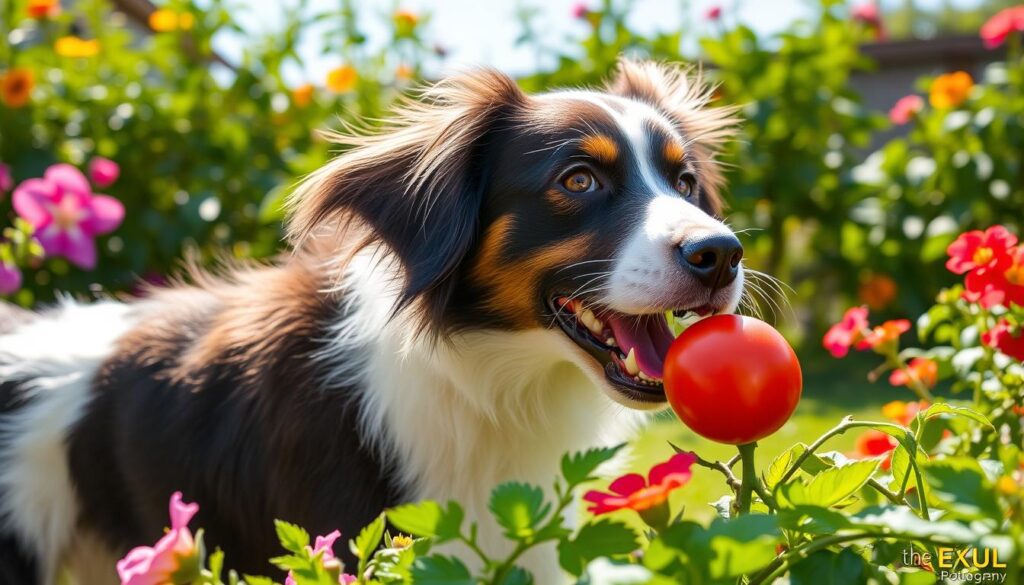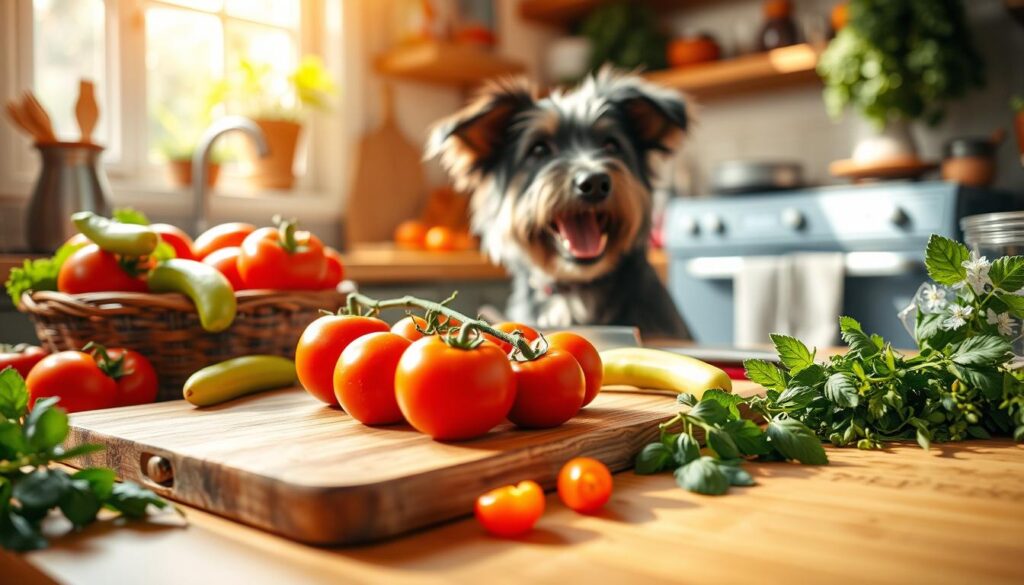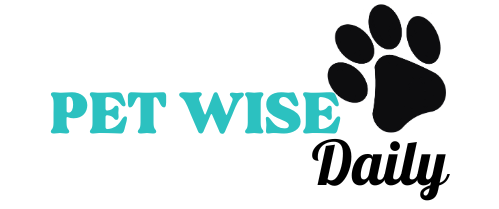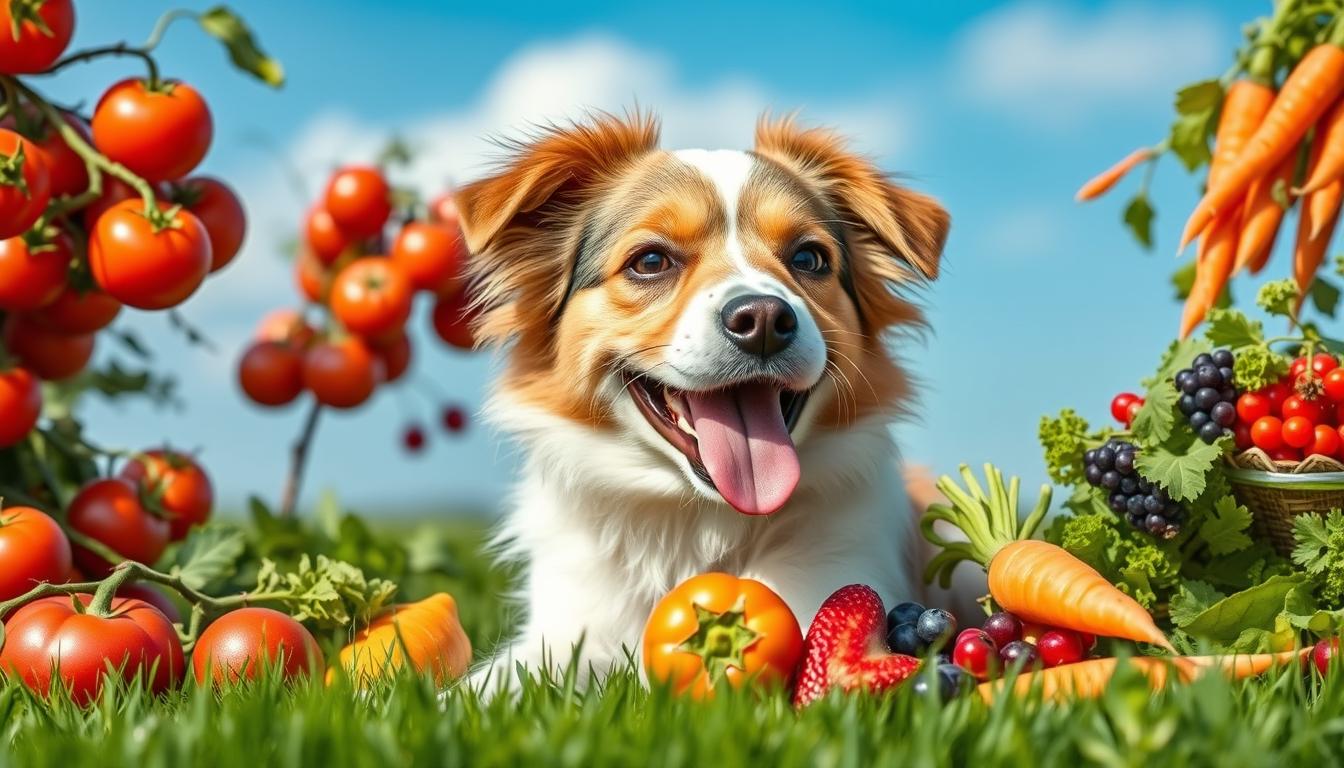Are you curious if dogs can safely eat tomatoes? As a caring pet owner, knowing the risks and benefits is key. Your dog’s health is always the most important thing.
In this guide, we’ll look at tomato safety for dogs. We’ll talk about the differences between ripe and unripe tomatoes, the toxins, and their nutritional value. By the end, you’ll know how to safely add tomatoes to your dog’s meals, keeping them healthy and happy.
Table of Contents
Understanding Tomatoes and Dogs: An Overview
As pet owners, knowing how tomatoes affect our dogs is crucial. Tomatoes are common in homes and can be good or bad for dogs. We’ll look at what makes tomatoes special and their link to the nightshade family. This is important for keeping your dog safe.
What Makes Tomatoes Special for Dogs
Tomatoes are full of fiber, antioxidants, vitamins C and K, and folate. These nutrients are great for your dog’s health and happiness.
The Nightshade Family Connection
Tomatoes are part of the nightshade family, along with potatoes and peppers. This is key because some nightshades can be toxic to dogs. Ripe tomatoes are usually safe, but avoid the green parts. They can harm your dog.
| Nutritional Benefits of Tomatoes for Dogs | Potential Risks from Unripened Tomatoes |
|---|---|
|
|
Understanding tomatoes and their nightshade family link helps pet owners. It lets us know how to safely add them to our dogs’ diets. Finding the right balance is essential for our pets’ health and happiness.
Can Dogs Eat Tomatoes
Can dogs eat tomatoes? The answer is a cautious yes. Ripe, red tomatoes are safe and healthy for dogs. But, it’s important to know the risks and serve them in small amounts.
Tomatoes are part of the nightshade family. They have a compound called solanine, which can be toxic to dogs in big amounts. The green parts of the tomato plant, like stems and leaves, are especially high in solanine and should be avoided. Start with a small amount of tomatoes for your dog; the appropriate quantity depends on their size, age, and existing diet.
Ripe, red tomatoes are good for your dog’s diet. They have vitamins A and C, lycopene, potassium, and fiber. These support your dog’s health, including vision, immune function, and kidney function. Moderation is key; ripe tomatoes can be a healthy and safe treat for dogs, but should not be overfed.
| Tomato Component | Safety for Dogs |
|---|---|
| Ripe, red tomatoes | Safe in moderation |
| Unripe, green tomatoes | Unsafe due to high solanine content |
| Tomato stems and leaves | Unsafe due to high solanine content |
If you want to add tomatoes to your dog’s diet, remove the seeds and stems. Avoid any seasonings or sauces, as they can be harmful. These can have too much salt, sugar, or toxic elements like xylitol.
Watch your dog’s reaction when trying tomatoes for the first time. Some dogs may have allergic reactions. This can include diarrhea, itching, skin rash, or vomiting. Tomatoes can cause allergic reactions in dogs, so observe your pet closely after the first serving.
By following these guidelines and serving tomatoes in moderation, you can safely add them to your dog’s diet. This provides a tasty and nutritious treat. Always consult with your veterinarian for personalized advice on your dog’s health and nutrition.
The Safety of Ripe vs. Green Tomatoes
Feeding your dog tomatoes can be tricky. Ripe tomatoes are safe and good for them. But, unripe tomatoes and parts of the plant can be harmful.
Why Ripe Tomatoes Are Safe
Ripe tomatoes have less tomatine, a toxin for dogs. As they ripen, tomatine levels go down. This makes them safe for dogs to eat in small amounts. They also have nutrients like chlorogenic acid, fiber, lycopene, potassium, and vitamins A, B9, C, and K1.
Dangers of Unripe Tomatoes
Unripe tomatoes have a lot of tomatine. This can make dogs sick. Symptoms include upset stomach, unsteady movements, and weakness. It’s best to avoid giving them to dogs.
Parts of Tomato Plants to Avoid
The leaves, stems, and green parts of tomato plants are also toxic. They have a lot of tomatine. These parts can be very harmful to dogs.
To keep your dog safe, remove the green parts before giving them ripe tomatoes. Wash the tomatoes well to remove pesticides. Cut them into small pieces to avoid choking.
| Tomato Variety | Nutritional Benefits | Recommended Serving Size |
|---|---|---|
| Ripe Tomatoes | Chlorogenic acid, fiber, lycopene, potassium, vitamins A, B9, C, and K1 |
|
| Roma Tomatoes | Lower in carbohydrates | Same as above |
| Organic Tomatoes | Potentially higher in vitamin C and phenolic compounds | Same as above |
While ripe tomatoes are safe for dogs, they should not be the main part of their diet. Always check with your vet before adding new foods to your dog’s diet.
Nutritional Benefits of Tomatoes for Dogs
Tomatoes are great for your dogs. They are full of fiber, which helps with digestion. Tomatoes also have antioxidants like lycopene, boosting your dog’s immune system.
Tomatoes are packed with vitamins C and K, and minerals like potassium and folate. These nutrients are key for strong bones and healthy cells. Vitamin C in tomatoes also strengthens your dog’s immune system.
| Nutrient | Benefit |
|---|---|
| Fiber | Supports healthy digestion |
| Lycopene | Powerful antioxidant that boosts immune function |
| Vitamin C | Strengthens the immune system |
| Vitamin K | Promotes healthy blood clotting and bone growth |
| Potassium | Supports heart health and muscle function |
| Folate | Assists in cell growth and development |
Remember, tomatoes are good for dog nutrition but should be given in small amounts. Too many tomatoes can upset your dog’s stomach. Always introduce new fruits for dogs or vegetables for dogs slowly and watch how they react.

Understanding Tomatine Poisoning in Dogs
As a pet owner, knowing the risks of certain foods is key. Tomatoes, especially green ones, can be harmful to dogs. They contain tomatine, a compound that can cause poisoning.
Common Symptoms to Watch For
Watch for these signs if your dog eats green or unripe tomatoes:
- Gastrointestinal upset: Vomiting, diarrhea, and loss of appetite
- Neurological effects: Drowsiness, weakness, loss of coordination, tremors, and seizures
- Cardiac issues: Irregular heartbeat and potential circulatory problems
When to Contact Your Veterinarian
If your dog eats any tomato plant part, call your vet right away. They can guide you on what to do next. This might include:
- Physical examination to assess the dog’s condition
- Blood work or other diagnostic tests to evaluate the extent of the toxicity
- Electrocardiogram (ECG) to monitor cardiac function
- Appropriate treatment, such as induced vomiting, activated charcoal, or supportive care
Quick vet care is vital. Tomatine poisoning can be serious if not treated. By acting fast, you can help your pet recover.
Safe Serving Sizes and Preparation Methods
Feeding tomatoes to your dog should be done with care. Ripe, fresh tomatoes can be a tasty treat. But, remember to keep the serving size in check.
For small dogs, a few pieces of diced tomato are enough. Larger dogs can have a few slices. But, always remove the green parts first. They have more tomatine, which can be harmful.
Consider pureeing or crushing the tomatoes for more benefits. This releases more lycopene, an antioxidant that’s good for your dog. You can even freeze the pureed tomatoes for a cool treat on hot days.
| Dog Size | Safe Serving |
|---|---|
| Extra-Small | Up to 2 x ½-inch cubes |
| Small | Up to 3 x ½-inch cubes |
| Medium | Up to 4 x ½-inch cubes |
| Large | Up to 5 x ½-inch cubes |
| Extra-Large | Up to 6 x ½-inch cubes |
Remember, tomatoes can be a homemade dog treat or a healthy part of your dog’s canine diet. But, introduce them slowly and in small amounts. Watch for any signs of upset stomach or allergies. If you’re unsure, talk to your vet about adding human food for pets to your dog’s diet.
Tomato-Based Products and Your Dog
As pet owners, we must be careful with what we feed our dogs. Tomato-based products are no different. While dogs can have ripe, red tomatoes in small amounts, processed tomatoes can be harmful.
Why Processed Tomato Products Are Dangerous
Canned tomatoes, tomato sauce, and ketchup often have bad stuff like garlic, onions, salt, sugar, and preservatives. These can upset a dog’s stomach, cause anemia, and more. The acidity in these products can also hurt a dog’s digestive system.
Hidden Ingredients to Watch Out For
- Garlic and onions, which can cause anemia in dogs
- Excessive salt, which can lead to electrolyte imbalances and other health problems
- Added sugars, which can contribute to obesity and diabetes in dogs
- Preservatives and other artificial additives that may be toxic to dogs
Stay away from tomato-based pasta sauces and pizza toppings too. They often have harmful ingredients. Always check the labels and avoid products with toxic additives.
Keeping our dogs safe is key. While a little ripe tomato is okay, it’s important to avoid processed tomato products. This helps prevent health problems.
Signs of Tomato Allergies in Dogs
Some dogs might be allergic to tomatoes, though it’s rare. If you’re giving tomatoes to your pet, watch for signs of an allergy. Look out for skin irritation, hives, coughing, wheezing, and trouble breathing.
If your dog shows these symptoms after eating tomatoes, stop giving them tomatoes and see your vet. Allergic reactions can be mild or severe. It’s important to act fast to keep your pet safe.
Always start with a small amount of new foods, like tomatoes, in your dog’s diet. This helps you see if there’s a bad reaction. Your vet can also tell you how much is safe for your dog’s size and health.

Being careful about pet foods allergies and dog nutrition helps your pet enjoy tomatoes safely. Always put your pet’s health first.
Garden Safety Tips for Dog Owners
As a responsible dog owner, it’s important to watch out for plants and garden features that can harm your pet. Tomato plants, part of the nightshade family, are common but can be toxic foods for dogs if eaten in big amounts.
To keep your dog safe, make sure tomato plants are out of their reach. You can fence off garden areas or put indoor plants high up. Always watch your dog in the garden to stop them from eating tomato safety concerns.
When cooking, keep your dog away from tomatoes and their green parts. Keeping the kitchen clean and safe is key to avoiding toxic foods for dogs.
By following these easy tips, you can lower the risks of tomato safety for your dog. This way, your pet can enjoy the outdoors safely. Always be informed and proactive in pet care to keep your furry friend happy and healthy.
Best Practices for Introducing Tomatoes to Your Dog’s Diet
Adding tomatoes to your dog’s diet can be good for them. But, you should do it slowly and carefully. Follow these steps to add tomatoes safely to your dog’s treats or meals.
Monitoring First-Time Consumption
Begin with a small tomato piece, like a grape. Watch your dog closely for 24-48 hours. Look for signs like vomiting, diarrhea, or tummy pain. If they seem okay, you can give them more over time.
Recommended Serving Methods
Give tomatoes plain, without any seasonings or sauces. You can mix them into your dog’s canine diet or as a homemade dog treat. Always wash the tomatoes well and remove green parts before giving them to your pet.
Be careful with how much human food for pets you give. Start small and watch how your dog reacts. This way, you can add tomatoes safely to their diet.
Conclusion
Ripe tomatoes can be a good treat for your dog’s dog nutrition, but only in small amounts. Make sure to remove any green parts and avoid processed pet foods with tomatoes. Also, introduce new foods slowly to your dog’s canine diet.
Watch for signs of tomatine poisoning and know the tomato safety risks. Always talk to your vet before adding tomatoes to your dog’s diet.
Knowing the good and bad of tomatoes for your dog helps you make better choices. A balanced diet is key to your pet’s happiness and health.
With careful planning, you can give your dog tomatoes as an occasional treat. This adds nutrients without risks. Always be alert and informed, and work with your vet for a healthy canine diet.


1 thought on “Can Dogs Eat Tomatoes – Pet Food Safety Guide”